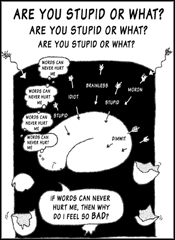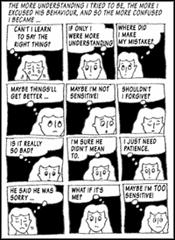 |
ViolenceIn Our Homes ...Against intimate partnersIntroductionWhile we are taught to be most afraid of assault by a stranger, violence most often happens within relationships. In intimate relationships, violence can take the form of physical, emotional, sexual and psychological abuse or economic control. Examples include physical injury and rape or threat of such acts, damage to property or pets, acts of intimidation, denial of food and money, isolation, coercion, and using children as a means of control. The Public Health Agency of Canada defines emotional abuse as including:
This type of abuse can go on for years. Its effects are devastating but largely invisible. Very often, children play a big part in the story. A woman in an abusive situation has to weigh her need to leave the situation against the stigma of being a single mother, fear of being perceived as an inadequate mother, and desperation to retain material and physical security for her children. Intimate partner abuse affects marginalized, racialised and aboriginal communities disproportionately because of the compounding nature of systemic oppressions. Not only lack of funding for advocacy and exit mechanisms, but also sexual stereotypes about lesbians, women of colour, women with disabilities, women living in poverty and aboriginal women cause many women to have less access to recourse in the criminal justice system. All the while a lack of resources tends to increase exposure to violence. Homophobia in society discounts lesbian and gay men's relationships. Hence it also obscures the reality that power, control and abuse can exist within them, so responses to these situations are inadequate. Physical injury—up to and including murder—is not the only outcome of intimate partner abuse. This type of abuse can cause people to feel a lack of control over their lives, depression and anxiety. It can lead to substance use, problems in other relationships and suicide. It can also lead to a stronger desire for education to make employment more available or more lucrative, yet making access to education more fraught, and learning success more elusive.
|
 |
 |
 |
- - - - - - - - - - - - -
Not all scars – Liz Lambert

- - - - - - - - - - - - -
Dating Violence
What does abuse look like?
Muslim Control Wheel
Sometimes religious beliefs are used to justify violence.
Power and Control Wheel for Lesbian, Gay, Bisexual and Trans Relationships
Violence and control tactics can exist in any relationship.
 Sally’s Story
Sally’s Story
If you don’t feel safe you know it’s abuse.
 A Woman’s Courage
A Woman’s Courage
The cycle of violence. When will it end?
Liz’s Survivor Story
Domestic violence in a same sex relationship
 Easy-to-read information about domestic violence.
Easy-to-read information about domestic violence.
Easy to read resources from Australia and London, England
Domestic Violence Information - from around the world
(in many different languages)
Emotional Abuse Assessment Guide
Guide for assessing emotional abuse.
An annotated bibliography and a literature review of Emotional Abuse of Women by their intimate partners
80% of sexual assaults occur at home.ii Internationally, 20% to 50% of women report having experienced violence at some point in their lives. They are at most risk from people they know, in particular from their male intimate partners.iii
While both men and women reported violence in their intimate relationships in Canada in 2004, women were much more likely to report more serious forms of violence, such as being choked, or threatened with a hand gun or knife. Women were more than twice as likely to report that they had been the targets of more than ten violent incidents, that they feared for their lives, and that they had been injured as a result. Also, between 1974 and 2003 the number of women killed by their partners has been 4 to 5 times higher than that of men killed by their partners.iv
Status of women Canada, Assessing Violence Against Women: A Statistical Profile
Measuring Violence Against Women: Statistical Trends
ii Alicia Summers, M.S. (2006). Children's Exposure to Domestic Violence: A Guide to Research and Resources
iii Sexual Assault Care Centre (1999). Myths and Facts About Sexual Assault
'iv Ending Violence Against Women', 2000, Abigail's Rebel.
 |
| Learning & Violence Home |
| BUILDING AN UNDERSTANDING: • The problem • Violence • Impact |
| EXPLORING POSSIBILITIES: • Learning processes • Helping yourself learn • Helping others learn • Learning to teach |
| CREATING CHANGE: • Changing education • Where in the world • Taking care of self |
| IMAGINING A FUTURE: • Dreams of a different world |
| Contact: jenny@learningandviolence.net |